Piraeus Tower is a Greek high-rise icon revived through sustainable strategies
The restoration of the Piraeus Tower is completed in Greece, revealing a revived façade by local architecture studio PILA

When we last visited Piraeus Tower on the Greek capital's coast in 2022 for our trip to explore the thriving Athens architecture and culture scene, the 1972 port icon was in the midst of a highly anticipated renovation.
A long-abandoned modern ruin and the second tallest high rise in Greece, the tower has now been reimagined as a mixed-use scheme, aimed at redefining the busy, yet somewhat architecturally neglected, port district of Piraeus. Local developer Dimand worked on a special new façade for the scheme with young studio PILA (local studio Betaplan acted as the lead architect for the overall scheme), founded by architect Ilias Papageorgiou, who left a partner position at New York’s SO-IL in 2019 to return to Athens and set up shop on his own.

Piraeus Tower: an icon revived
‘After ten years of a harsh economic crisis, Greece is undergoing a rapid transformation on many fronts,’ Papageorgious said at the time. ‘This building is situated on a really important part of the wider city of Athens. We see the “awakening” of the abandoned structure of the tower as sparking a broader regeneration, allowing for the life of the city to move closer to the water.’

During the same trip, Dimand COO Olga Itsiou added: 'The Piraeus Tower was an unfinished building, a sleeping giant for more than 40 years. It has never operated except for minimal commercial uses on the ground and first two floors. It was not filled with people. [Now], offices, shops, a gym, an all-day restaurant, and a café will enable approximately 2,000 people to work there.’

Completed this summer, the main building has been transformed into sleek offices and retail space. A second phase, currently in the works, will include public landscaping, aiming to further revitalise the surrounding context and reframe the port’s pedestrian access and circulation via a new green footbridge.

For now, Piraeus Tower is up and running, flying the flag for sustainable architecture and retrofitting. The team was keen to implement a range of eco-friendly strategies; for example, its louvres, which reduce solar gain on the façade by 45 per cent; façade elements chosen following light pollution studies; the use of photovoltaic panels; and the recycling of more than 5,000 sq m of glass during construction, a proportion of which was installed as new glass in the project.

The project, hailed by its authors as the 'first green high rise in Greece', is nothing if not ambitious, awarded the first LEED Platinum certification for a building of its type in the country, while highlighting the potential of adaptive reuse.
Wallpaper* Newsletter
Receive our daily digest of inspiration, escapism and design stories from around the world direct to your inbox.

'The rejuvenation of Piraeus Tower exemplifies adaptive reuse at its finest. By reimagining existing structures, we can transform our city into a more sustainable and livable environment,' said Papageorgiou and his partner at PILA Christina Papalexandri on the occasion of the opening.
Ellie Stathaki is the Architecture & Environment Director at Wallpaper*. She trained as an architect at the Aristotle University of Thessaloniki in Greece and studied architectural history at the Bartlett in London. Now an established journalist, she has been a member of the Wallpaper* team since 2006, visiting buildings across the globe and interviewing leading architects such as Tadao Ando and Rem Koolhaas. Ellie has also taken part in judging panels, moderated events, curated shows and contributed in books, such as The Contemporary House (Thames & Hudson, 2018), Glenn Sestig Architecture Diary (2020) and House London (2022).
-
 Three new coffee makers for a contemporary brew, from a casual cup to a full-on branded espresso
Three new coffee makers for a contemporary brew, from a casual cup to a full-on branded espressoThree new coffee makers, from AeroPress, Jura and Porsche x La Marzocco, range from the defiantly manual to the bells and whistles of a traditional countertop espresso machine
By Jonathan Bell Published
-
 Don't miss Luxembourg's retro-futuristic lab pavilion in Venice
Don't miss Luxembourg's retro-futuristic lab pavilion in VeniceAs the Venice Biennale enters its last few weeks, catch 'A Comparative Dialogue Act' at the Luxembourg Pavilion
By Amah-Rose Abrams Published
-
 A Berlin park atop an office building offers a new model of urban landscaping
A Berlin park atop an office building offers a new model of urban landscapingA Berlin park and office space by Grüntuch Ernst Architeken offer a symbiotic relationship between urban design and green living materials
By Michael Webb Published
-
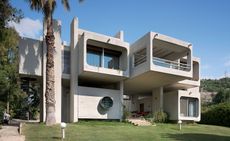 Remembering Alexandros Tombazis (1939-2024), and the Metabolist architecture of this 1970s eco-pioneer
Remembering Alexandros Tombazis (1939-2024), and the Metabolist architecture of this 1970s eco-pioneerBack in September 2010 (W*138), we explored the legacy and history of Greek architect Alexandros Tombazis, who this month celebrates his 80th birthday.
By Ellie Stathaki Published
-
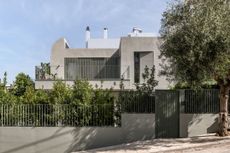 Tour House D in Athens, where interiors are peachy keen
Tour House D in Athens, where interiors are peachy keenDesigned by Cometa Architects, House D in Athens is full of curvy, colourful character
By Ellie Stathaki Published
-
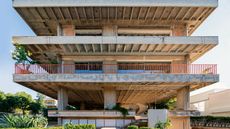 Three Object Apartment embraces raw concrete honesty in the heart of Athens
Three Object Apartment embraces raw concrete honesty in the heart of AthensThree Object Apartment by DeMachinas is a raw concrete home in Athens, which confidently celebrates its modernist bones
By Ellie Stathaki Published
-
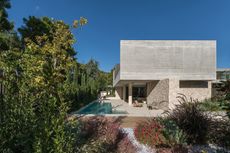 Residence in Dionysos was conceived as a minimalist ‘cave refuge’ outside Athens
Residence in Dionysos was conceived as a minimalist ‘cave refuge’ outside AthensResidence in Dionysos by Desypri & Misiaris Architecture is a family home designed as a minimalist refuge among the surrounding nature's pine tree-filled slopes
By Ellie Stathaki Published
-
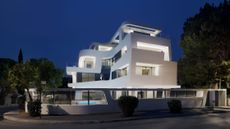 This Greek villa's superyacht aesthetics conceal two self-contained family residences
This Greek villa's superyacht aesthetics conceal two self-contained family residencesA Greek villa in the upscale Athens suburb of Filothei, House Symbiosis is home for two sibling families, designed in white, sweeping volumes by Direction Architects
By Jonathan Bell Published
-
 A Filothei house rises to the occasion in its angled Athens plot
A Filothei house rises to the occasion in its angled Athens plotA Filothei house by Kallos Turin is an Athens residence rising to the occasion on an angled plot
By Ellie Stathaki Published
-
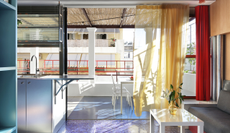 This colourful Athens apartment takes small space living to a new level
This colourful Athens apartment takes small space living to a new levelPocketed away on a residential street, this colourful Athens apartment smartly utilises every inch of its footprint with segmented flooring and rich textural design
By Tianna Williams Published
-
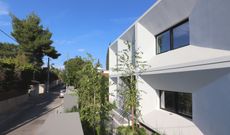 KKMK, Greece: Wallpaper* Architects’ Directory 2023
KKMK, Greece: Wallpaper* Architects’ Directory 2023The Wallpaper* Architects’ Directory 2023's newest entry is Greek studio KKMK, behind projects such as this minimalist haven in Athens’ Psychiko
By Ellie Stathaki Published